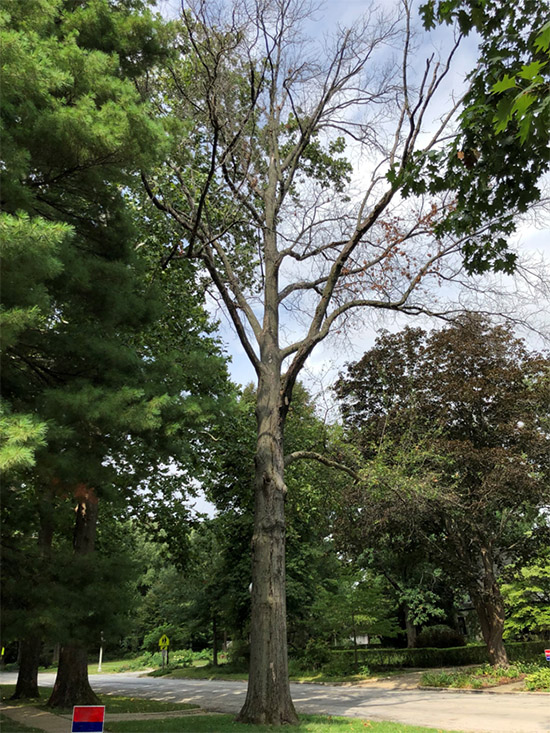Issue 16, September 26, 2018
Biscogniauxia Canker and Diedback
Biscogniauxia (pronounced Bisk-o-nee-ox-e-a) canker and dieback is a disease that takes advantage of stressed and weakened host trees. Outbreaks of the disease occur following stress events. These events may include growing seasons with intense heat, prolonged drought, or any injury to a tree's root system. While the disease is capable of infecting a variety of tree species, oaks within the red oak group are particularly susceptible. Over the past several years, I have observed numerous pin oaks in central Illinois succumb to this disease.
Biscigniauxia canker is a fungal disease caused by the pathogen Biscogniauxia atropunctata (formerly Hypoxylon atropunctatum). The fungus enters the tree through wounds and natural openings in the bark. In healthy trees, the fungus survives as small colonies in the bark and sapwood but is kept in check by the tree's natural defenses. Hot, dry conditions cause water stress within the host trees, allowing fungal colonies begin rapid growth. The fungus then causes a decay of sapwood, inner bark tissues, further disrupting the flow of water and nutrients through a tree. The early symptoms of the disease are consistent with drought stress. Branches often have wilting, yellowing, or smaller than normal leaves. Affected trees often have thin canopies with visible dieback. Large girdling cankers form as the disease progress down to the trunk, eventually killing the tree (Photo 1).

Photo 1. Advanced Biscogniauxia canker and dieback on oak. stromata visible in the upper canopy and lower trunk.
The best way to diagnose Biscogniauxia canker it to look exposed stromata (compact masses of mycelium) that typically appear the year after a severe predisposing event. Cushion-like fungal stroma form under the bark and exert pressure between the wood and bark of the tree. The pressure eventually causes the bark to slough off the tree, revealing a tan to brown colored fungal stroma (Photo 2). Later, the stroma turns silver in color, and finally black.

Biscogniauxia canker on oak. Note the Tan colored stromata (orange arrows)
Unfortunately, there are no control measures for trees with extensive cankers and dieback. No chemicals are registered for Biscogniauxia canker and dieback on oaks. Management centers on prevention and sanitation. Avoid wounding trees, especially their root systems. Maintain good cultural practices such as proper fertilization and watering during hot, dry weather. Prune out dead or declining limbs from trees suspected to be infected disease. This may help to control the spread of the fungus on a tree. Severely infected trees should be promptly removed. Infected wood should be destroyed immediately to keep the disease from spreading. (Travis Cleveland)
Author:
Travis Cleveland